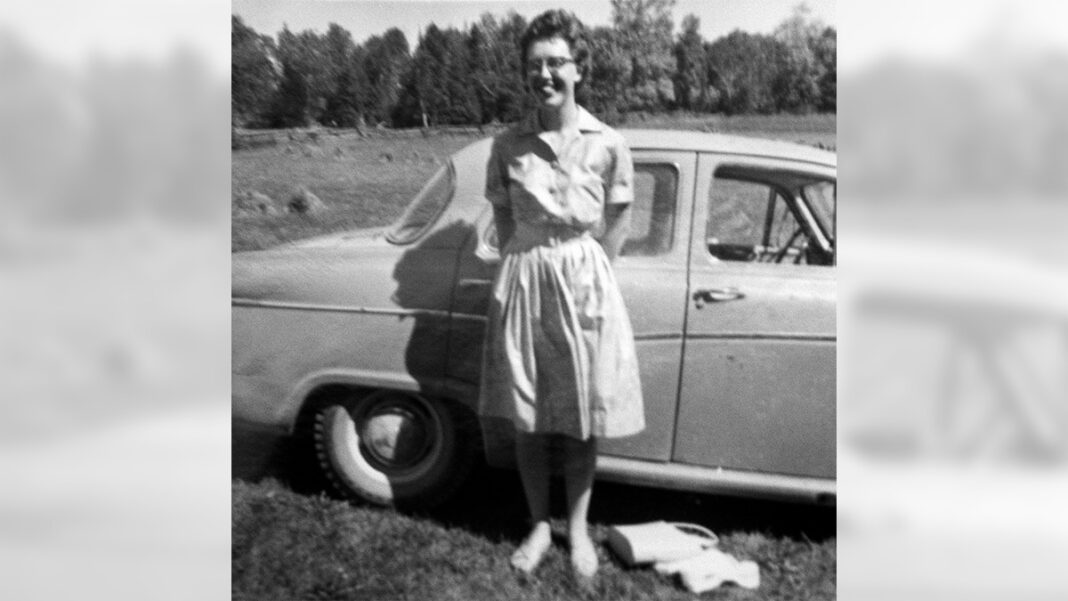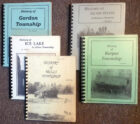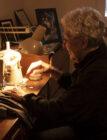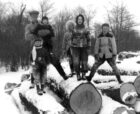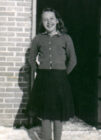by Petra Wall
Pat Best is well-known for the formidable project of researching and writing several historical epics that help immortalize the early pioneer stories of Western Manitoulin. She is a true Haweater with several generations of ancestors on the Island since settlement began. The ‘History of Mills Township’ was finished in 2005, and four other similar projects followed, taking a total of eight years for all five. Pat’s early career of teaching began after attending Teacher’s College in Toronto. She taught in Sudbury, the Cambridge area, and Manitoulin Island. Pat also served on Gordon Township council and was the reeve for two terms. After the children started school, Pat became a bookkeeper for H & R Noble Construction for many years. Following this, she learned to do upholstery, running ‘Best Upholstery’ from her home, and created many beautiful quilts. These days, Pat makes her home in the Millsite Apartments in Gore Bay.
Paternal great-grandparents are Marshall John Orford, born in 1840, and Sarah (McKay) Orford. They arrived in Mills Township in 1881, with some of their adult children and registered their land in 1886 on Orford Road, off Poplar Road. Paternal grandparents are Martha Baker and Donald Orford. They had three children including John, Pat’s father and two girls (both of whom died with cancer in the 1930s). Grandfather Donald died from a heart attack in his fifties. “John, my father, was planning a career in banking but when his father died, he came home to run the farm. In 1936, he married Mary Granger, the daughter of William and Alice (Stevens) Granger, of Gordon Township. It was not long before a second tragedy, a chimney fire, claimed the family home and most of their possessions. Grandmother Martha continued to live with our family in the new house, built with community help. Dad was the only family she had left since her daughters had passed away.”
Pat was born on March 2, 1939, to John and Mary Orford. Doctor Strain was attending another birth, but he finished, went home, got a new team of horses and then drove out over the snowbanks to see Mary. The birth went smoothly. Pat had an older brother Jack and would have six more siblings, Don, Lois, Floyd, Murray, Marian and Doug. “Because Dad stayed home to farm, he luckily missed going to war. Grandmother taught me to read with the Grade 1 reader which featured Mary, John and Peter and cost four cents at the local drug store. Once school started, we had access to lots of wonderful books like Anne of Green Gables, The Bobbsey Twins, the Hardy Boys and the Zane Grey books.”
“On the farm, a much larger barn was raised in 1941, again with the help of the community. Dad was one of the first farmers in Mills to get a tractor.” The new house had only four rooms, two upstairs and two downstairs. Grandmother had two rooms and the family had the other two rooms which had to accommodate Mary, John and four children at the time. “Luckily, Grandmother allowed me to sleep with her. We did a lot of things together, including her teaching me to read, sew and knit.”
“When my older brother Jack turned seven, I started school and we both walked over two miles there and back. There were no neighbours to accompany us. In the winter, the way home was dark. I remember being afraid that a bear or a wolf would appear but we were lucky and always made it back with no ‘wild’ encounter. I liked schoolwork, and concerts were especially fun.”
“In 1946, while still in Grade 1, we bought a new farm, south of Poplar corner, closer to the school, and with neighbours nearby. One of my best early memories happened in 1951 when hydro came into our area. I was 12, had always been nearsighted and now I was amazed at how bright my world became. Before hydro, dad would take the gas lantern to the barn for the milking and leave us with just a dim coal oil light. Now we had lights everywhere. In preparation for that wonderful event, we had already purchased our electric refrigerator from Dad’s cousin, Charlie Robertson. This was a great replacement for the old icebox in the shed that had tried to keep food cool in the summer. It wasn’t long before an electric washing machine replaced the scrub board and the hand cranked machine that itself had been a great replacement in its day. By the mid-fifties, Doug was born. Our house had grown too, with a big addition.”
“At home, my main interest was sewing. We had two Singer, treadle sewing machines, one with white thread and one with black for mom to keep up with needed repairs for her large family. I loved all fabric, the way it looked, and the feel of the texture. It would be ordered from the Eaton’s catalogue and local stores. Knitting was important too. Cooking and cleaning were never my favourite tasks but as the oldest girl, I was responsible for specific chores and looking after the younger children. One chore I disliked was collecting eggs. The hens would peck at my hands.”
“For high school, our parents took turns driving us, until about 1955 when a bus was hired. After finishing high school, all the boys left home for further education or work. They got jobs at INCO, or in construction-related jobs in Sudbury and beyond. Once they accumulated some money, they all bought land on the Island and eventually all became successful farmers on Manitoulin with good skills in building and fixing. Jack owned a cattle truck and that activity led to the establishment of the well-used Little Current Sales Barn. Marian travelled extensively but settled in the mountains of British Columbia where she and husband Ian, a skilled carpenter, still ski and enjoy outdoor life. Lois and her family also spent 30 years in British Columbia before she returned to Manitoulin in her senior years.”
Pat left home at 17 to study teaching. “In 1956, I took the train from McKerrow to Toronto where I studied at the Teacher’s College for a year. My grandmother had always insisted that I would become a teacher. At that time, the two main jobs held by women were nursing and teaching.” Her new talents were first used for the Grade 6 class at the Lansdowne Public School in Sudbury. “I liked this work. Two of us taught the Grade 6 classes. There had been no sports previously at this school so we both decided to take on this challenge. Without a gym, all the activities had to be outside: softball, volleyball, track and field. The big stack at INCO had not gone up yet, so on certain days, smog made it hard to see across the schoolyard. You could taste the acid in the air.”
After three years in Sudbury, Pat took a teaching position in a new rural school, outside of Galt, now Cambridge. About 30 students were distributed in eight grades in one room. There was a modern oil furnace, and the lessons had to be highly organized. After one year, buses had been brought in for all the schools so that each location had only one or two grades. Pat taught for three years for this school board and made a lifelong friend.
Pat recalls her summer trip west with three other teachers. “We left in an old Vauxhall with a tarp covering our tent, pots and sleeping bags on the roof. We camped most of the summer in the Canadian west and in the United States. We enjoyed new sights and campfire singsongs with Jane and her ukelele. The following year, another group of us went east and saw much of that coast but we didn’t get to Newfoundland.”
In 1963, Pat felt it was time to move home. “Mother was not well and needed help. I bought a good sewing machine that I still use and I taught at the old Union School, where the Burpee Mills Complex is now. It was a tiny one-room school with about 25 students. To keep classes productive, I would combine some of the classes and let other classes do assignments. We had two recesses, and the students brought their lunches so all of us stayed at the school. We had a caretaker to light the stove each morning and ensure the wood supply was replenished. As part of the recreational component, our school played baseball and other sports with neighboring schools and staged a popular Christmas concert. At recess, baseball and ‘auntie-I-over the woodshed,’ throwing a ball over the shed, were popular.”
It wasn’t long before Pat was dating Edward Best whom she had known for several years. He had a sister, Marianne, and he farmed with his dad, Irwin Best, in Gordon Township, producing many potatoes. His mother, Edith (Brockelbank) loved flowers, especially African violets, which covered her dining room table. Edward was a happy-go-lucky guy, fun to be with and known for his contagious laughter. He worked part-time at his Uncle Orval Brockelbank’s electrical business and for The Gordon Telephone Company, doing installations and repairs. About 1964, Edward and his dad bought the McArthur farm across the road.”
“We married on July 24, 1965, at the Gore Bay United Church. Timing was good; first haying was finished, and the new grain was not ripe yet. I had sewn my dress and those for the three bridesmaids. Our church hall supper and reception were attended by family, friends and neighbours. After our trip to the Thousand Islands, we set up our home in the farmhouse with the McArthurs. We used the living room and the upstairs. We got along well, and this arrangement lasted almost six years.”
“I left teaching at Christmas 1966 before the birth of our daughter, Heather. Sons Brent and Darren joined Heather to complete the family. For a while, we had three in cribs to save space. Darren’s crib was in the hall closet. I was always taking in sewing from clients. When the new high school in Gore Bay opened in 1969, I started teaching sewing two nights a week there. Soon, Cambrian College set up courses on Manitoulin and I was the registrar for all their courses, ranging from woodworking to electrical as well as sewing.”
“In 1971 the McArthurs moved to town and we had the whole house to ourselves. In 1974, we built an addition to the back of the house, allowing us to add a basement and a furnace. In 1980, we took a family camping trip in an old Chevy with a big trunk that carried all our stuff. I did all the cooking and the driving. The kids set up camp each night. Our destination was the west coast, specifically the homes of my two sisters, one living on Vancouver Island. Edward flew out to meet us after the haying to accompany us home. Lots of good memories remain.”
When the kids were all in school, Pat began to work for Randy Noble who was establishing H & R Noble Construction after working with his dad. At first, Pat worked with his mother, Renie, a well-known educator who had helped to set up the Flower of Hope School and later, the Hope Farm. Pat loved her bookkeeping role and stayed for many years.
“Our daughter Heather attended Wilfred Laurier and later became a very busy chartered accountant. Her husband Dave Hall is an electrician and they have two children, Parker, and Ally. Brent is single. He attended Sheridan College for technical training. After Edward’s sudden death in 2000, from a hospital infection, Brent came home to run the farm. Darren works in ‘IT’ technology near Toronto. He attended Ryerson University and he is married to Heatherlee. Their daughter Chiara is still in school.”
Starting in 1985, Pat served on the Gordon Township Council. She was Reeve for two terms and ended her political life in 2006. “It was the time that 911 system came to Manitoulin and roads were named. I met leaders from all over the Island.”
Throughout her years on the farm, Pat was very active in the Gordon Women’s Institute, a valuable organization that taught rural women and girls the skills they needed. One of their objectives was to preserve rural family histories, called “Tweedsmuir Histories.” Pat was instrumental in continuing the work of Jean Wismer in getting quite a few stories and pictures into scrapbooks. This work was one of the inspirations that got her started writing in 2004. She used the same format of telling the story of each 100-acre surveyed farm when she began writing ‘The History of Mills Township,’ naming each one after its inhabitants in the 1950s, which seems to have been the last years that one such parcel would allow a farmer to earn a living. Following the successful completion, four more histories were written, namely Burpee, Gordon, Ice Lake and Silver Water, completed in 2013. Luckily these are still available and sold in their respective township offices.
“One of the first influential settlers in Mills was my Great-Grandfather John B. Baker who had 12 children, the first three boys who helped ‘open up’ the land in Mills. John established a sailboat business starting with the ‘Northern Belle,’ brought up on the rear deck of a ship. The Northern Belle would transport people and packages from Gore Bay to the Lake Wolsey area near their home. The smaller boats could get through the Barrie Island Causeway, but the bigger boats had to take the longer route around Barrie Island. In 1877, for his first winter on Manitoulin, John had only hazelnuts and the wildlife they could trap or fish, to sustain his family. The new settlers learned much from the local Anishinaabe folk who traditionally traversed these areas.”
Each year, John would head back to Meaford to pick up an ox or a sailboat. “I remember the cow story. John was taking two cows to be bred at another farm. There were no bulls in Mills Township. He had to secure them on a raft to cross the water. The cows were successfully bred and put back on the raft to go home. Part way back, one cow panicked and jumped over the rail, breaking her neck. John had lost half his herd in one day.”
Any special memories you recall? “In 1949, dad bought a second farm with a bush lot. He spent one year taking out logs and sold these and bought snowsuits from the Eaton’s catalogue for all four of us, our first purchased clothing.
Favourite season? “Spring, when everything comes to life in those beautiful soft green colours. The weather is warmer, flowers are emerging and the days are getting longer.”
Favourite book? “When I was young, ‘Anne of Green Gables’ opened up my world.”
Favourite collections? “Fabrics of all kinds. I love to visit fabric stores and feel those textures.”
Favourite trip? “The family trip to British Columbia.”
Television shows you like? “Game shows, news, and documentaries like W-5.”
Favourite holidays? “Summertime barbecues and gatherings with friends and family.”
What are you most proud of? “My family and my books which help preserve the history of the Island.” What are you most afraid of? “Falling and losing my independence.”
Anything that surprised you along life’s journey? “I was surprised that I could just leave my home on Manitoulin long ago and successfully teach 35 kids at age 18.”
Anything special you want to add about your passion for quilting? “I have made many quilts throughout the years, all hand-quilted or machine quilted in a method called ‘Quilt as you Go.’ I loved designing my own quilts, with help from other quilters, magazines and the internet. Some have been given to family and well-used or even worn out and four have been donated to the Angel Bus Organization. Last summer, a quilt earned them $6,200 in ticket sales. A few have won ribbons at quilt shows. Quilt-making continues to be a passion to this day, with a couple currently on the go.”
Awards? “The Queen’s Diamond Jubilee Medal was given to me by the Gordon Township Council for many years of service in 2012.
What are your strengths? “Numbers, quilting, organization.” It seems that Pat is also talented in writing history.
Something you still want to do? “Travelling was never a strong urge. I have lived my life the best way I could in the time I’ve had. “Now,” she smiles, “I would just like to find a pair of pants long enough for me.”
Going back in time, is there anything you would change? “Not really. I might have started my accounting work earlier.”
Hope for the future? “That people will learn to get along. Also, we really need less ‘junk,’ too much of it is produced, is wasted, and clutters our landfill areas. I am against too much consumerism.”
Recipe for happiness? “Be content with what you have. Try new things. Have fun. Use your time wisely to benefit your family and others. Try not to waste time. Try to be useful into your old age.” Pat still loves to cut lots of grass out on the farm on her John Deere riding lawn mower.
“Manitoulin is my home from start to finish. I am happy. The children did well on the Island and they either live here or return here. I lived away briefly but my heart was always here and I knew I would come back home again soon. Knowing the folks here has always been important to me. We have such gorgeous sunsets. Lastly, I feel empathy for all the early settlers that carved out a living on our ‘Rock’ and helped to make the Island a unique and special place to live. I’ve tried to preserve their history for future generations.”

